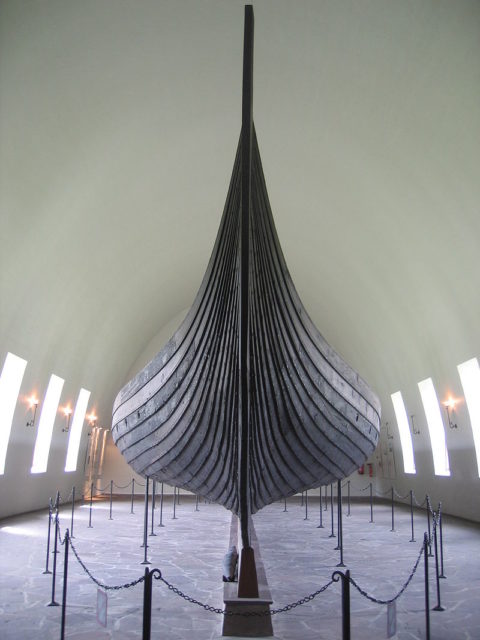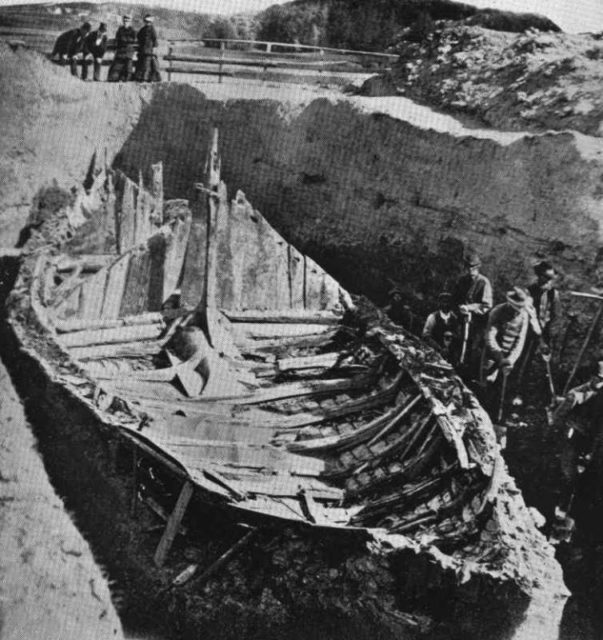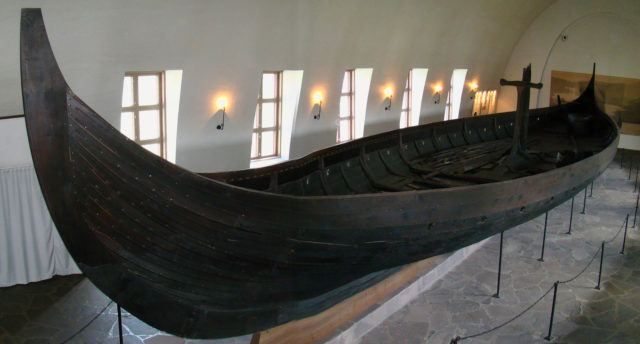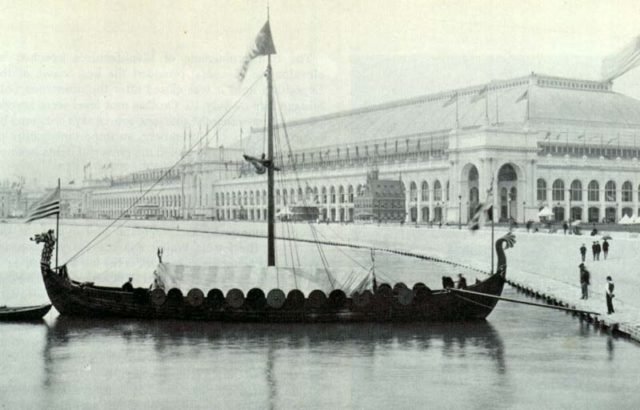The Gokstad ship is a 9th-century Viking ship found in a burial mound at Gokstad in Sandar, Norway. The site where the boat was found, situated on arable land, had long been named Gokstadhaugen or Kongshaugen(from the Old Norse words konungr meaning king and haugr meaning mound), although the relevance of its name had been discounted as folklore, as other sites in Norway bear similar names.
 https://commons.wikimedia.org/w/index.php?curid=839681" />The Gokstad ship at the Viking Ship Museum in Oslo, Norway By Karamell – Own work, CC BY-SA 2.5,
https://commons.wikimedia.org/w/index.php?curid=839681" />The Gokstad ship at the Viking Ship Museum in Oslo, Norway By Karamell – Own work, CC BY-SA 2.5,In 1880, sons of the owner of Gokstad farm, having heard of the legends surrounding the site, uncovered the bow of a boat while digging in the frozen ground. As word of the find got out, Nicolay Nicolaysen, then President of the Society for the Preservation of Ancient Norwegian Monuments, reached the site during February 1880. Having ascertained that the find was indeed that of an ancient artifact, he liaised for the digging to be stopped. Nicolaysen later returned and established that the mound still measured 50 meters by 43 meters, although its height had been diminished down to 5 meters by constant years of plowing. With his team, he began excavating the mound from the side rather than from the top down, and on the second day of digging found the bow of the ship.
The Gokstad ship is clinker-built and constructed largely of oak. The ship was intended for warfare, trade, transportation of people, and cargo. The ship is 23.80 meters (78.1 ft) long and 5.10 m (16.7 ft) wide. It is the largest in the Viking Ship Museum in Oslo. The ship was steered by a quarter rudder fastened to a large block of wood attached to the outside of the hull and supported by an extra stout rib. The block is known as the wart and is fastened by osiers, knotted on the outside and passed through both the rudder and wart to be firmly anchored in the ship.
 Gokstad Viking ship excavation. Photographed in 1880 Source:Wikipedia/Public Domain
Gokstad Viking ship excavation. Photographed in 1880 Source:Wikipedia/Public DomainThere are 16 tapered planks per side. The garboard planks are near vertical where they attach to the keel. The garboard planks are narrow and remain only slightly wider to take the turn of the bilge. The topside planks are progressively wider. Each oak plank is slightly tapered in cross section to allow it to overlap about 30mm the plank above and below in normal clinker (lapstrake) style. Iron rivets are about 180 mm apart where the planks lie straight and about 125 mm apart where the planks turn.
At the bow, all of the planks taper to butt the stem. The stem is carved from a single curved oak log to form the cutwater and has one land for each plank. The inside of the stem is hollowed into a v shape so the inside of the rivets can be reached during construction or repair. Each of the crossbeams has a ledge cut about 25 mm wide and in depth to take a removable section of decking. Sea chests were placed on top of the decking to use when rowing.
Most likely on longer voyages sea chests were secured below decks to act as ballast when sailing. The center section of the keel has little rocker and together with flat midships transverse section the hull shape is suited to medium to flat water sailing. When sailing downwind in high winds and waves, directional control could be difficult, so it is likely that some reefing system was used to reduce sail area. In such conditions, the ship would take water aboard at an alarming rate if sailed at high speed.

 http://bjornfree.com/galleries.html, CC BY-SA 3.0,
http://bjornfree.com/galleries.html, CC BY-SA 3.0,  Gokstad ship replica Viking at the World’s Columbian Exposition Chicago in 1893.Source:
Gokstad ship replica Viking at the World’s Columbian Exposition Chicago in 1893.Source:












Pentru a putea adăuga comentarii trebuie să fii membru al altmarius !
Alătură-te reţelei altmarius